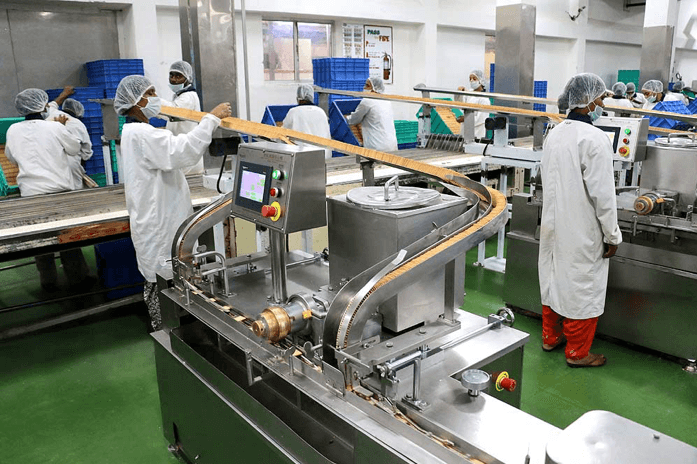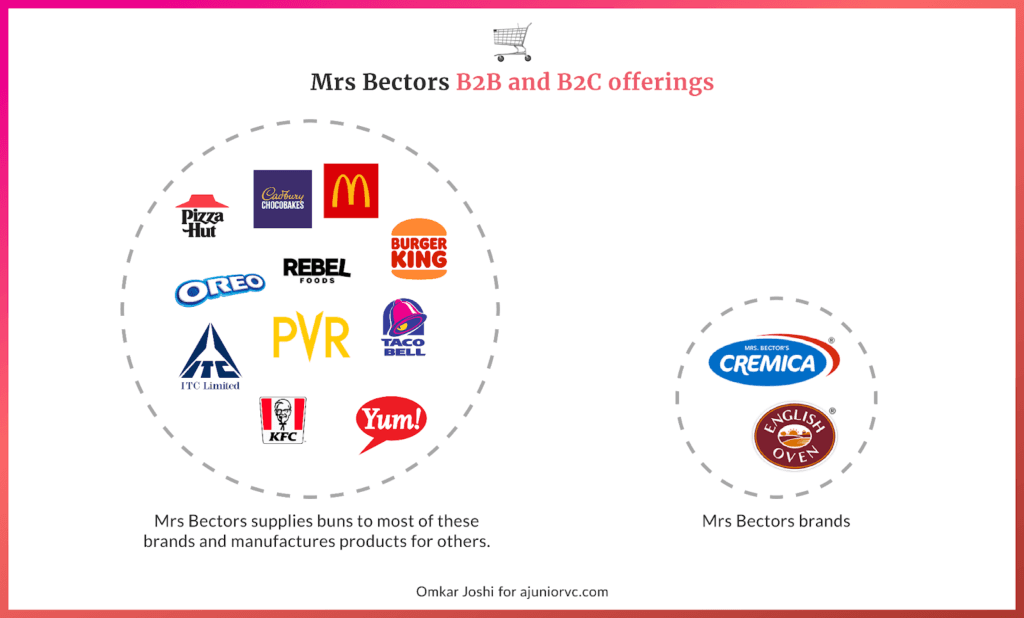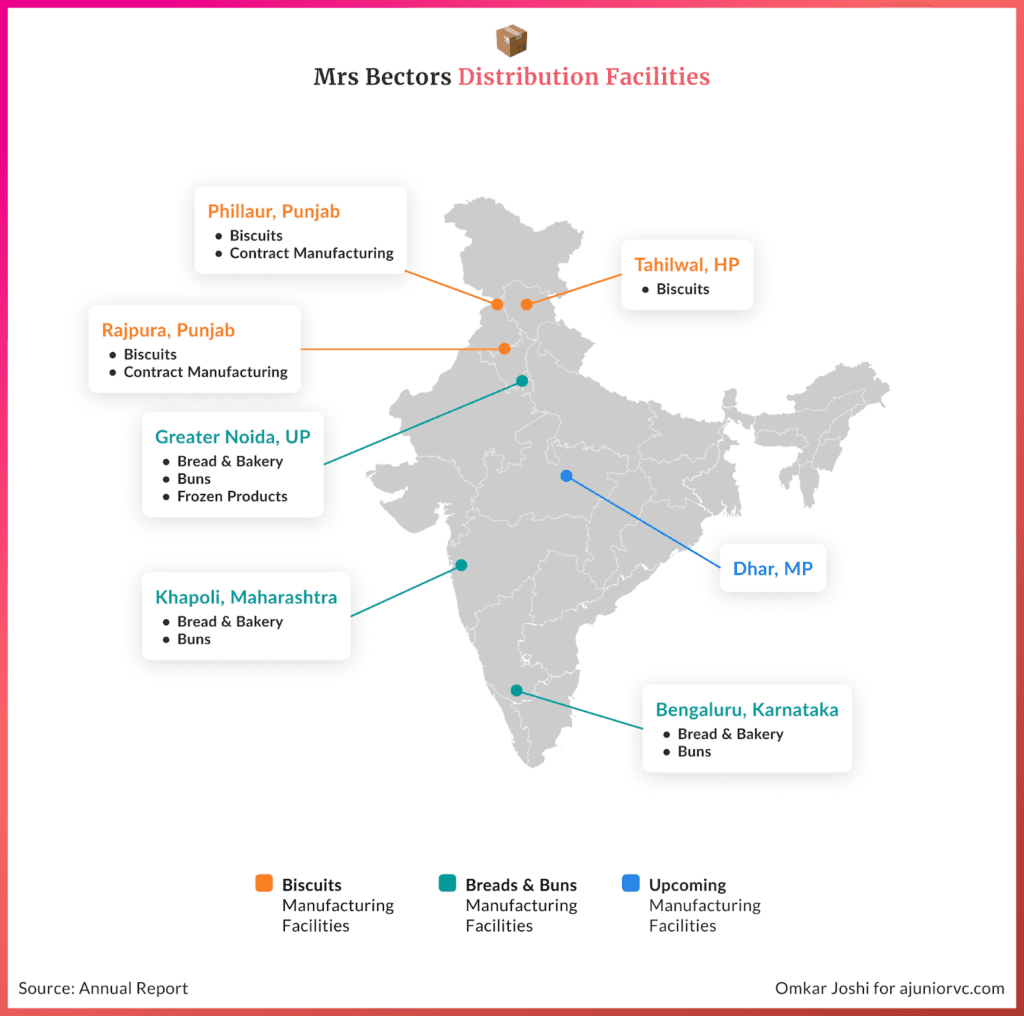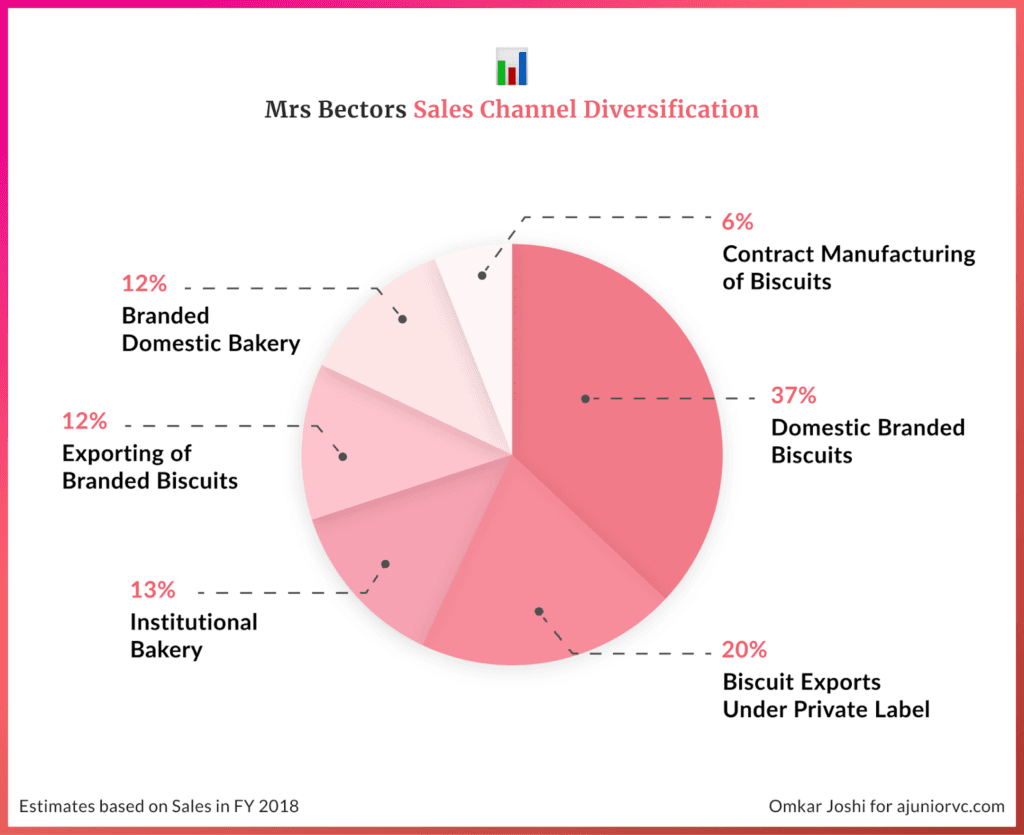
May 14, 2023
Can Mrs Bector’s Turn Mother’s Baking into a Unicorn?
Profile
Food
Brand
IPO
B2C
B2B
Retail
Mrs Bector’s completed an epic run-up in market cap last fortnight, eclipsing its IPO price as it entered Mother’s Day on a 3,000 Cr+ market cap
Bake it Till You Make It
Rajni Bector was born in Karachi in 1940, she moved to India after Partition.
At 17, she was married in a Ludhiana-based business family even before she could graduate from Miranda House. With three sons sent to boarding school, Rajni enrolled on a bakery course at Punjab Agriculture University.
She soon gained popularity for her baking recipes and ice creams. Of those who praised her, she recalls two people vividly. “Brijmohan Munjal of Hero Motocorp and the Pahwas of Avon cycles have complimented me: ‘Rajni, you have introduced Ludhiana people to good food.’”.
She gained so much popularity that the local Member of Parliament asked her to cook her specialities for 2,000 guests and she did with the help of just 2 other cooks.
This encouraged her to invest INR 300 to set up an oven and ice-cream churner in her backyard.
Remember that two guys and a garage story from Silicon Valley. This was our version of that.
Mrs. Rajni Bector’s started the business in 1978 in Ludhiana, Punjab.

Much like her unique surname, several parts of this story are unique. Imagine anyone starting a business then, more so a woman. This was the India of License Raaj that was yet part socialist, gender equality and women empowerment were yet to enter people’s lexicon.
Overwhelmed by the orders and unable to make profits, Rajni incurred losses.
Her husband, Dharamvir intervened and supported her with a princely sum of Rs 20,000 to start an ice cream manufacturing unit in 1978. Rajni already lived a life of luxury as her husband and his family were well-off.
This was a passion project.
Her husband, who was very particular about branding, made another important contribution. One day he called up Rajni to register the business under a brand.
Asking her to quickly think of a name — whatever came to her mind. Since she used a lot of creams to make her products, she thought of Cremica [Cream ka], and that is how the brand was born in the 80s.
Cremica’s demand took off, slowly, they soon started making breads and biscuits. Bector never advertised her products much.
The buzz was primarily generated through word of mouth, considering she received many orders for weddings, parties, and caterers.
Rajni had a flair for food, and it was showing.
In 1985 she decided they needed to move to a more prominent place, so she invested INR 50,000 to set up a bread unit in Punjab which could bake 5,000 loaves a day, followed by an automated line to make 50,000 loaves in 1989.
Her husband’s century-old trade in fertilisers, oil, and food grains faced a massive setback in the 1990s. Terrorism ramped up in Punjab and tensions between Hindu traders and Sikh farmers increased.
The family decided to wind up the business and focus on the baking business. Her two younger boys, Akshay and Anoop joined the business.
By the 1990s, Cremica was an INR. 5 crore business.
The business grew exceptionally when the family joined hands, scaling to INR 20 crore.
Batch Made in 10,000 Cr Baking Heaven
By the early ’90s, the company stepped in to make bread, buns, biscuits and sauces.
With bread manufacturing sorted, a biscuit plant was commissioned in Ludhiana in 1991. They also opened an ice cream parlour in Sarabha Nagar in Ludhiana then. It was a small and dull market then, but the parlour changed its fortunes. Today, it is Ludhiana’s top market.

The early ‘90s were a great time to be doing business in India. India’s then Finance Minister had just opened up the economy via reforms in 1991, attracting large international brands to our shores.
This was to be a significant development for Cremica too.
By the mid-‘90s, her eldest son, who had completed his engineering degree from Manipal, also joined the business.
1996 was a monumental year for the company and probably made things real.
That year, the company bagged the contract to supply McDonald’s with buns, ketchup, and toppings. Going down the B2B route was an interesting choice for a consumer brand, and as things turned out it was a masterstroke.
The McDonald’s partnership led to the company entering into two joint ventures.
The first was with Quaker Oats to supply ketchup, mayonnaise, tartar sauce, and other liquid condiments to McDonld’s and the second is with the U.K.-based EBI Foods Ltd. for manufacturing batter and breading pre-mixtures for McDonald’s.
Less than a decade later, Mrs. Bectors Food bought out both the JV businesses.
Interestingly in its early days, the McDonald’s deal wasn’t a large opportunity financially because McDonald’s was setting up their base in India.
However, what the company gained from the collaboration was more intangible. The McDonald’s team’s technical training in food safety, low-cost production and certification was priceless.
Cremica took these skill sets to their other factories, including bakery, biscuits, and cookies. This enduring relationship gave them an edge in an otherwise competitive market.
While the partnership with international partners helped build a focus on quality, the company always retained its DNA of constantly innovating new products, substituting ingredients with local alternatives and reformulating existing products.
Rajni was a perfectionist, and her mantra of ‘quality at all costs’ runs through the company to this date.
Rajni was also clear while innovation was necessary, it must never come at the cost of good taste. All new product launches made under the Cremica label had to earn her approval before they were commercially produced. This tradition continued well past her retirement as well.
As the company entered the 2000s, it was truly going national.
Quality is the Knead of the Flour
Delivering quality consistently has been table stakes at Cremica.
When there was a spike in tomato prices, many companies reduced the tomato paste content in tomato ketchup, but Cremica remained consistent with its ingredient percentage.
The quantity of tomato paste in Kissan Fresh Tomato Ketchup made by HUL had decreased from 28% to 22.5%, and in Maggi Rich Tomato Ketchup made by Nestle India from 28.1% to 26.7%. Tomato paste content in brands like Del Monte (29%) and Heinz (26%), as well as Indian brands like Cremica (34.5%) and Safal (35%), has not come down.
Many multinational companies started taking note of Cremica and its high standard of food. The company’s factory in Phillaur, Punjab started making biscuits sold by Cadbury’s and ITC’s Sunfeast.
The company was now well diversified in its product range, including jams, ready-to-eat food and snacks segments.
It became a key supplier to an extremely diverse base of HUL, Big Bazaar, Spencer, Sodexho, Taj Group, ITC Group, Jet Airways, Indian Airlines, Barista, Café Coffee Day, Pizza Hut, Domino’s and Papa Johns.

With the brand growing across segments, revenues swelled to INR 100 Cr. by 2006.
This was the same time the company sold 21% of its shareholding to Goldman Sachs for around Rs 70 Cr valuing the company at close to INR 500 Cr
INR 50 Cr. of the capital raised was used to expand the business further. The business had started expanding, and Cremica had plants in Greater Noida, Mumbai, and Una in Himachal Pradesh.
By 2010 the Cremica Group was the third largest ketchup maker in the country, one of the largest manufacturers of vegetarian mayonnaise and the sole supplier of buns, liquid condiments, batter and breading to McDonald’s India.
However, in 2010, Goldman Sachs exited and sold its share to Motilal Oswal.
As a recession had hit the world, this was a distressed sale. Motilal Oswal bought out the shares for Rs 44 crore.
It would end up being an almost seed-like investment.
Competing Isn’t a Piece of Cake
In 2010, Mrs Bector's was already known in the baking industry, but they needed to rise above the competition.
Determined to bake their way to success, the company opened a state-of-the-art manufacturing facility in Rajpura, Punjab, India.
This facility was no ordinary dough-mixing operation; it was a battery of advanced technology and strict quality standards, enabling Mrs Bector's to whisk up their production capacity and meet the overwhelming demand.
However, while Mrs Bector's was measuring up, their competitors were baking their moves.
Not content with just crumbs of success, Britannia introduced a range of products like flavoured yogurt and dairy-based beverages, hoping to stir up the packaged food market.
Parle was also rolling up its sleeves, kneading to strengthen its position and expand its distribution network. They had investment plans to increase their manufacturing capacity.
Meanwhile, ITC had big appetite for growth in the food business. They were mixing their strategies, stirring up the ready-to-eat and convenience food segment with instant noodles, snacks, and frozen meals.
Mrs Bector's realised they needed to thaw new ideas to stay ahead.
To meet the challenge, Mrs Bector's decided to be creative and expand their product portfolio to include frozen snacks.
This was no piece of cake, but they were determined to whip up a wider range of options for their consumers.
With frozen snacks, Mrs Bector's could cater to a cool crowd. From those with a sweet tooth to those who prefer savoury treats.
In 2012, the company whipped a storm by introducing new variants of frozen bakery and syrups.
India was experiencing a rise in disposable income, giving consumers more dough to spend on premium food products and experiences.
The bakery industry witnessed a surge in artisanal and gourmet products, leaving Mrs. Bector's with a recipe for success.
They decided to scoop up the opportunity and launched a range of premium ice creams. Under the brand Cremica Creams, Mrs Bector's gave customers the scoop of their dreams. This launch topped off the charts, aligned with the trend of premiumization. Customers were willing to shell out more for these treats.
By 2014, Mrs Bector had baked their way to success, with five manufacturing facilities and a revenue of over Rs. 500 crores.
They had risen to the occasion, proving that when it comes to the food industry, Mrs. Bector's would take the cake
The cake that was the bakery market was on a tear.
Sweet Profit Pools
The bakery industry has risen to be the oldest food processing industry in the world, kneading its way through time for over 30,000 years.
This industry is worth over $500 billion globally, proving it's no half-baked business.
It's worth more than the GDP of some countries.
India, the second-most populous country, needs baked goods significantly. By 2016, the bakery industry in India had risen to a colossal Rs. 50,000 crores, with projected growth at a CAGR of 9% for the next five years.
That's a whole lot of dough to roll in.
But then, Mrs. Bector emerged from the oven, ready to show off their baking prowess and prove they were more than just a run-of-the-mill bakery.
They realised they had to be omnipresent, spreading their sweet and savoury goodness far and wide. It was time to rise to the occasion!
Mrs. Bector's Food Specialties Limited focused on buttering up its distribution channels.
They whisked their way into partnerships with distributors, forming crusty connections with vital retail chains, supermarkets, and food service providers. They aimed to ensure their treats were as accessible as freshly baked bread.
These partnerships were the secret ingredient to their success, allowing them to impress big names such as Burger King while having a wonderful partnership with Hardcastle Restaurants (master franchise of McDonald’s in India).
They launched new products and brands like "Cremica Foodz" to cater to the ever-changing tastes of consumers. These goodies were devoured with delight, helping Mrs. Bector's increase their market share.
Mrs. Bector's continued beyond local conquests; they spread their baking magic to over 1,000 towns in India, leaving no loaf unturned.
In 2018, Cremica Food Park emerged as the catalyst for Cremica Foods' tomato paste production.
This remarkable venture swiftly attracted the participation of approximately 1500 farmers involved in tomato cultivation, who eagerly joined forces with Cremica as their trusted suppliers, ultimately blossoming into prosperous producers themselves.
With state-of-the-art Italian technology, Cremica Food Park boasted an impressive daily capacity of 650 tonnes, operating at an astounding production rate of 30 tonnes per hour per line.
And they didn't stop there,
Their treats reached the borders, as they started exporting to 64 countries. Their products were saying, "We're global breadwinners!"
But they were just getting started, leaving no stone un-turned
Rising to the Top
In a competitive market, Mrs. Bector's has risen to the top, capturing attention with its performance in the bakery sector.
Their numbers tell a story
Mrs. Bector's Cremica boasts some impressive unit economics, putting them on par with other big players like Britannia and ITC.
How they compete with such well-oiled giants is decades of R&D, fixated on a culture of quality.
They have mastered the art of producing high-quality bakery products at a lower cost, giving them a competitive edge.
They know how to whip up delicious treats while controlling the material costs. The gross margin of Mrs Bector’s is 40%, close to Britannia despite being 1/10th of the revenue scale.
But that's not all; Mrs. Bector's Cremica has spread its buttery goodness to key regions like Punjab, Himachal Pradesh, Jammu & Kashmir, and Haryana. They have secured a 4.5% market share in the premium and mid-premium biscuits market in North India.
With such a strong presence, they have the upper crust when negotiating with farmers and sourcing ingredients.
While other brands might focus solely on B2B or B2C segments, Mrs. Bector's Cremica has mastered the art of playing both sides. By supplying directly to chains and restaurants, they have a solid customer base and enjoy revenue streams without burning a hole in their pockets with high marketing costs.
Selling costs are almost trivial, 1% of the company’s revenue. These are at least ~5-6% of larger players’ revenue. However, every bakery has muffin tops; for Mrs Bector’s, it's the employee cost.
Compared to Britannia's ~4% of sales, Mrs Bector's employee cost jumps to ~15%. This could be indicative of a growth company that is yet to get to scale.
Mrs. Bector has a pan-India presence and a global portfolio. However, most of the revenue comes from northern India, with 60% of overall revenue coming from the biscuits segment.
On the other hand, Britannia is more diversified and hedged regarding products and revenue streams.
This is the very reason why Mrs. Bector is investing in the expansion.
In 2018, they set their sights on new horizons and established a state-of-the-art Greenfield facility in Dhar, Madhya Pradesh. They opened a window to the West and South Indian markets, providing delicious treats to a broader customer base.
They also acquired land in Khopoli, adjacent to their existing factory in Mumbai.
Diversification beyond their core regions and core products was necessary to win.
Spreading to Win
As they continued to invest in opening new facilities, Mrs Bector’s placed equal emphasis on building a robust distribution network.
The sales team continued to build relationships with new retail stores. By 2018 they had retail partnerships in 26 states in India with a network of 748 distributors who supplied to 458K retail outlets
Backed by a robust manufacturing and distribution infrastructure, Mrs Bector’s continued aggressively experimenting with product innovation and market alignment.
The company launched India’s first vegetarian mayonnaise, introducing Indian-flavoured sandwich mayo like tandoori and mint.
They also decided to introduce niche products into allied value-added product categories. They launched several items such as sub breads, pizzas, garlic breads, cheese garlic bun fills and frozen cookies.
The quality scaling to bread with a brand like English Oven became a big wedge for the Western market.
Because their distribution network will take it forward, Mrs Bector’s expanded its offerings to include niche products.
The company went deeper into a nutritious range of biscuits. The focus on premium bakery products was a critical differentiator that drove sales in urban India with higher disposable incomes and changing meal preferences.
The premium categories also helped it realise higher margins.
Mrs. Bector's didn't just mix it up, they rolled with the changes and launched Ajwain and Jeera biscuits to cater to the diverse regional tastes of India. This was just the icing on the cake, as their expanding distribution reach and innovative products helped their rise to the top of the baking industry in Rajasthan, Haryana and other markets.
The Indian biscuit industry witnessed revenue growth of around 8% CAGR between FY2017 to FY2020. On the other hand, Mrs. Bector's Food Specialties Limited reported revenue growth of 15.7% CAGR during the same period, which is higher than the industry average.
With strategically located production facilities close to its target markets, Mrs Bector’s minimised freight and logistics-related expenses and time.
The company's net profit growth of 18.3% CAGR from FY2017 to FY2020 was higher than the industry average. Mrs Bector's reported a net profit margin of 9.8% in FY2020, higher than the industry average of 8.1%.

Mrs Bector’s didn’t stop at that.
Flouring the Public Markets
In December 2020, the company acquired Harvest Gold, a famous bread and bakery products brand in northern and western India, in an all-equity deal.
The deal was worth approximately Rs. 340 crores (around $46 million). Harvest Gold was a renowned premium-mid brand with a 5% share in the bread segment
With Mrs Bector’s already a household brand, they also saw immediate success in these new categories. Mrs Bector’s became one of the largest-selling brands in the premium bakery segment in Delhi NCR, Mumbai and Bengaluru.
It was also one of the few bakery companies in India that could handle fresh, chilled and frozen products. This helped it distribute its portfolio of bakery products consisting of ~100 SKUs pan-India.
Heeled by solid growth and high brand awareness, Mrs Bector’s went public in 2020. With high capex investments in expanding product portfolio, the return ratios fell over the FY18-FY20 period, but investors gauged future success.
In 2020, Mrs Bector's Cremica raised a whopping Rs. 540 crores through an IPO to fuel their expansion plans. The IPO received an overwhelming response, with investors subscribed for a staggering ₹40,000 crore shares.
The massive interest saw it oversubscribed 198 times, making it one of the year's highest-subscribed IPOs.
The country was finally getting a taste of the delicious treats Mrs. Bector and her company had been serving for years.
In 2021, Mrs Rajni Bector was awarded the prestigious Padma Shri award for contributing to the food processing industry.
The little bakery from Ludhiana was now truly every house’s bakery.
Mrs Bector's kept its commitment to quality and value at the forefront of their selling points.
They invested in expanding their manufacturing capacity and keeping all production in-house to maintain brand consistency. This set them apart from competitors such as Britannia and Parle, who utilise a mix of in-house and outsourced production.
This investment paid off with continued brand loyalty and satisfaction from QSRs and institutional customers.
Fending off competition, Mrs. Bector’s became one of the largest suppliers of buns to leading QSRs like Mcdonald's. They continue to be manufacturers of bigwigs like Mondelez India Foods Private Limited. Mrs. Bector’s is also one of the largest biscuits suppliers to the Canteen Stores Department of the Government of India
This relationship with several customers gave them higher brand visibility.
In the domestic markets, they gained retail clients across 26 states and institutional customers pan India.
With an extensive manufacturing infrastructure and widespread and well-established distribution, Mrs Bector’s continued to look for more areas to expand.
To increase factory utilisation rates, they began producing items under private labels. This presence across diversified sales channels would also act as a mitigant against a slowdown in any segment.
When the pandemic shut down the F&B sector, Cremica Foods’ business took a 30% hit. However, biscuit sales continued to rise during the pandemic.
A testimony of their strength in product innovation and manufacturing, outside India also Mrs Bector’s made a strong foothold in the biscuits category, catering to clients in 64 countries across 6 continents.
Its biscuits export market commands a 12% market share making it the second-largest exporter of biscuits globally.
The world was now its bakery for the taking.
Mother’s Day to Shine
Mrs. Bector's commitment to continuous innovation is evident in its impressive product portfolio.
As of FY21, the company offered a staggering 384 stock-keeping units (SKUs) in the biscuits category and 118 in the bakery category, showcasing its ability to cater to diverse customer preferences and needs.

Today exports contribute 22% of total sales for the company, followed by the branded bakery and QSR businesses at 17% each. At the same time, the rest of the revenue comes from the domestic biscuits business.
Mrs Bector has built an empire in biscuits and bakery items that appear to be untouchable.
The company has expanded its global reach by exporting its products to various countries, encompassing the Middle East, Africa, and Southeast Asia.
In a strategic move to decrease reliance on exports and quality management, the company is establishing manufacturing facilities in these regions. The company is also making significant investments in marketing and advertising initiatives to effectively promote its products in these targeted countries.
The company has been growing steadily in recent years, with revenue and profit increasing by an average of 7.87% and 18.22%, respectively til 2021
Mrs. Bectors has a healthy financial position, with a debt-to-equity ratio of 0.38 and a current ratio of 2.05. The company also has a strong promoter holding of 51.14%.
The company's revenue increased by 40% to track ~1,400 Cr for the year. This was driven by solid growth in the biscuit segment, which grew by 13.4%. The PAT is tracking 100 Cr+ in FY23, from ~60 Cr in FY22.
Better execution is a crucial driver for this change.

The future looks bright for Mrs Bectors.
This is a bit of an unconventional story that warms your heart, makes you cheer for the protagonist, and eventually has a happy ending. Maybe an excellent script for a Bollywood movie.
With almost 2x growth over the last 5 years for a consumer brand, it is a guide for young Indian brands trying to make it.
On Mother’s Day, one must never underestimate the power of a Mom to take her love beyond the household to eventually a 3,000 Cr food powerhouse.
Writing: Mitali, Parth, Samarth, Varun and Aviral Design: Omkar and Chandra